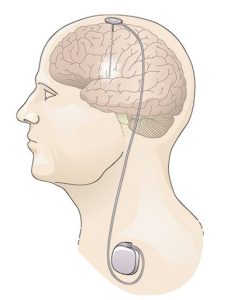2 Deep Brain Stimulation
Welcome to the second day of the YSP-REACH Program. Now that you have learned more about neuroscience and neural engineering, you may be wondering how this research can be translated into therapy and treatment. Today we will focus on a type of neurotechnology used to transform the lives of people with neurological disorders and injuries. Today you will hear about deep brain stimulation from Dr. Jeffery Herron, an associate professor in the UW Department of Neurological Surgery.
Deep Brain Stimulation
 One example of neurostimulation is Deep Brain Stimulation (DBS). Deep brain stimulation (DBS) is a technology that was developed originally to control the debilitating symptoms of Parkinson’s disease. The use of DBS has expanded and is now being used to treat other conditions including essential tremor, dystonia, epilepsy, and obsessive compulsive disorder. A deep brain stimulator consists of a device, similar to a cardiac pacemaker, that is implanted surgically near the neck or in the upper chest. The device delivers electrical signals to an electrode implanted in brain tissue. The method requires invasive brain surgery, but for many patients, DBS therapy can improve the quality of a patient’s life. Learn more about deep brain stimulation by exploring the resources below. In addition, tomorrow’s learning resources will include information about how neuroethicists have grappled with the ethical implications of DBS treatments and their impact on the patients who receive these devices.
One example of neurostimulation is Deep Brain Stimulation (DBS). Deep brain stimulation (DBS) is a technology that was developed originally to control the debilitating symptoms of Parkinson’s disease. The use of DBS has expanded and is now being used to treat other conditions including essential tremor, dystonia, epilepsy, and obsessive compulsive disorder. A deep brain stimulator consists of a device, similar to a cardiac pacemaker, that is implanted surgically near the neck or in the upper chest. The device delivers electrical signals to an electrode implanted in brain tissue. The method requires invasive brain surgery, but for many patients, DBS therapy can improve the quality of a patient’s life. Learn more about deep brain stimulation by exploring the resources below. In addition, tomorrow’s learning resources will include information about how neuroethicists have grappled with the ethical implications of DBS treatments and their impact on the patients who receive these devices.
Although deep brain stimulation is considered to be low risk, there may be complications and side effects. For example, because the implantation of DBS electrodes requires that small holes are made in the skull and a pacemaker-like device is inserted under the skin, it is possible that an infection may result around the incision sites. Bleeding in the brain is another possible risk. Electrical stimulation of the brain can also cause numbness or tingling sensations and changes in mood.
Watch this 5 minute video about using DBS to treat Parkinson’s disease.
Learn about Deep Brain Stimulation (DBS)
- The Cleveland Clinic provides an introduction to Deep Brain Stimulation. Click through the tabs to learn about the surgical procedure, risks/benefits, and recovery process.
- Read an article and watch a video that shows how DBS can help reduce the symptoms of essential tremor: “Brain Signals Deliver First Targeted Treatment for World’s Most Common Movement Disorder.”
- Read Deep Brain Stimulation: Current Challenges and Future Directions
- Deep Brain Stimulation (brief overview)
In this Day 4 Padlet, think of some underlying neurophysiological, neuroanatomical, or neurochemical mechanisms by which DBS might work. In other words, what do you think happens to the brain when it receives electrical stimulation?
Then, hit the “back” arrow on your web browser to return to this chapter and keep reading.
Tomorrow we will hear about electrical stimulation of the nervous system from our guest speaker Dr. Chet Moritz. Dr. Moritz is developing neurotechnological solutions for patients who have suffered from a spinal cord injury.
Citations: DBS illustration: National Institute of Neurological Disorders and Stroke.
A disorder of the nervous system.
A device in which electrodes are surgically implanted into brain tissue and connected to an impulse generator implanted under the skin. The device directs targeted, painless electrical pulses to a specific area of the brain.

